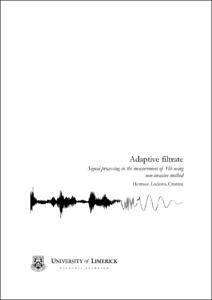Mostra el registre d'ítem simple
Adaptive filtrate: signal processing in the measurement of haemoglobin using non-invasive method.
| dc.contributor | Leen, Gabriel |
| dc.contributor.author | Herruzo Lodeiro, Cristina |
| dc.contributor.other | Universitat Politècnica de Catalunya. Departament de Teoria del Senyal i Comunicacions |
| dc.date.accessioned | 2014-10-16T09:14:42Z |
| dc.date.available | 2017-10-17T00:30:27Z |
| dc.date.issued | 2014-07-14 |
| dc.identifier.uri | http://hdl.handle.net/2099.1/23086 |
| dc.description.abstract | This project is part of another project which is currently running at the University of Limerick (Ireland) and who is objective is to measure the concentration of haemoglobin (Hb) in blood using a non-invasive optical method. A sensor system, which basically consists of: four optical sources emitting light of different wavelengths; a photodiode which has a response in the appropriate wavelength range; a circuits for signal conditioning and low level processing of the information; and various software algorithms to interpret and calculate the Hb concentration. The main sensor elements are integrated into a finger clip. Despite advances in the development of monitoring systems for haemoglobin using non-invasive techniques, there is still a significant amount of research and development (R&D) required. One of the areas which requires further R&D is to minimise the unwanted effects of motion artefacts on the signal obtained from the photodiode. Through the development of hardware (e.g.: accelerometer, gyroscope, laser and monitor diode, etc.) and software (motion-resistant algorithms), it will gradually achieve the goal of highly accurate and immune to Motion Artefact. This project focuses on the software development. The main objective is to evaluate a number of methods which could potentially remove these motion artefacts through the use of adaptive filtering. One popular adaptive filtering techniques used in such situations is the noise canceller and this option will be explored in the project. In addition different adaptive algorithms will be compared in order to obtain the best solution. Simulations in Matlab and Labview will be used because the latter software is used extensively in the main Hb analysis programme. This project report has the following structure: - Introduction to non-invasive haemoglobin monitoring by LED based optical sensor system. - PPG signal features and motion artefact. - Theory related to adaptive filtering and adaptive algorithms. - Code and simulations in both Matlab and Labview. |
| dc.language.iso | eng |
| dc.publisher | Universitat Politècnica de Catalunya |
| dc.subject | Àrees temàtiques de la UPC::Enginyeria de la telecomunicació::Processament del senyal::Processament de la imatge i del senyal vídeo |
| dc.subject.lcsh | Algorithms |
| dc.subject.lcsh | Adaptive filters |
| dc.subject.lcsh | Signal processing -- Digital techniques |
| dc.subject.other | Adaptive filtrate |
| dc.subject.other | Adaptive algorithms |
| dc.subject.other | Filtrado adaptativo |
| dc.subject.other | Algoritmos adaptativos |
| dc.subject.other | Procesamiento de la señal |
| dc.title | Adaptive filtrate: signal processing in the measurement of haemoglobin using non-invasive method. |
| dc.title.alternative | Filtrado adaptativo: procesamiento de la señal en la medición de hemoglobina mediante un método no invasivo |
| dc.title.alternative | Filtrat adaptatiu. Processament del senyal en el mesurement de la hemoglobina mitjançant un mètode no invasiu |
| dc.type | Master thesis (pre-Bologna period) |
| dc.subject.lemac | Algorismes |
| dc.subject.lemac | Filtres adaptatius |
| dc.subject.lemac | Tractament del senyal -- Tècniques digitals |
| dc.identifier.slug | ETSETB-230.101955 |
| dc.rights.access | Open Access |
| dc.date.updated | 2014-10-15T05:51:31Z |
| dc.audience.educationlevel | Estudis de primer/segon cicle |
| dc.audience.mediator | Escola Tècnica Superior d'Enginyeria de Telecomunicació de Barcelona |
| dc.audience.degree | ENGINYERIA DE TELECOMUNICACIÓ (Pla 1992) |
| dc.contributor.covenantee | University of Limerick |


